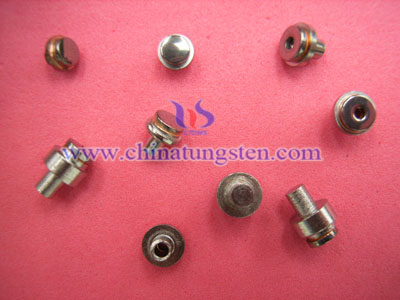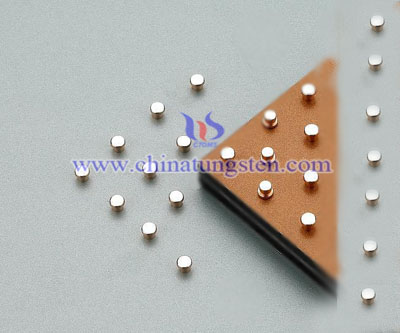Notes of Silver Tungsten points Prepared by Infiltration
- Details
- Category: Tungsten Information
- Published on Monday, 13 July 2015 16:47
- Written by Yahong
- Hits: 365
Notes of silver tungsten points prepared by infiltration are shown as follows:
1. The thickness of the tungsten powder. The closed pores inside tungsten porous skeleton will increase and then influence silver (liquid metal)’s entry if tungsten powder is too thin.
2. The structure of tungsten skeleton. The silver tungsten points could get the best electrical contact performance as the porous tungsten skeleton has firm and interconnected network structure. Besides, it can form the desired porous tungsten skeleton structure when the tungsten powder possesses a certain particle size and particle size composition. It is a network of firm and interconnected tungsten particles and has open pores with smooth surface.
3. Infiltration temperature. Infiltration temperature will have an effect on the quality of silver tungsten points. The viscosity of the liquid will be reduced to benefit infiltration if the temperature is too high. However, it is detrimental to the infiltration because the surface tension of the liquid is also reduced. The porous tungsten skeleton strength after sintering will decrease if the temperature is too low. And you should prolong the sintering time to make it be conducive to economic production.

Tungsten Metals Manufacturer & Supplier: Chinatungsten Online - http://www.tungsten.com.cn
Tel.: 86 592 5129696; Fax: 86 592 5129797
Email: sales@chinatungsten.com
Tungsten & Molybdenum Information Bank: http://i.chinatungsten.com
Tungsten News & Tungsten Prices, 3G Version: http://3g.chinatungsten.com
Molybdenum News & Molybdenum Price: http://news.molybdenum.com.cn
Matters Needing Attention of Silver Tungsten Contacts Prepared by Infiltration
- Details
- Category: Tungsten Information
- Published on Monday, 13 July 2015 16:44
- Written by Yahong
- Hits: 342
Matters needing attention of silver tungsten contacts prepared by infiltration are the following:
1. Tungsten powder’s thickness. If tungsten powder is too thin, then, the closed pores inside tungsten porous skeleton will increase, affecting silver (liquid metal) to enter.
2. The structure of tungsten skeleton. Only when the porous tungsten skeleton has interconnected and firm network structure, the prepared silver tungsten contacts can get the best electrical contact performance. Besides, only the tungsten powder having a certain particle size and particle size composition, it will be able to form the desired porous tungsten skeleton structure. It is a network of interconnected and solid particles consisting of tungsten particle and has open pores with smooth surface.
3. Temperature. Temperature will affect the quality of silver tungsten contacts. If the temperature is too high, the viscosity of the liquid will be reduced in favor of infiltration, however, because the surface tension of the liquid is also reduced, so that is detrimental to the infiltration. If the temperature is too low, and after sintering, the porous tungsten skeleton strength decreases, you need to extend the sintering time and is not conducive to economic production.

Tungsten Metals Manufacturer & Supplier: Chinatungsten Online - http://www.tungsten.com.cn
Tel.: 86 592 5129696; Fax: 86 592 5129797
Email: sales@chinatungsten.com
Tungsten & Molybdenum Information Bank: http://i.chinatungsten.com
Tungsten News & Tungsten Prices, 3G Version: http://3g.chinatungsten.com
Molybdenum News & Molybdenum Price: http://news.molybdenum.com.cn
Dissolution Behavior of Calcium Tungstate in Oxalic Acid Solutions
- Details
- Category: Tungsten Information
- Published on Monday, 13 July 2015 16:34
- Written by xinyi
- Hits: 369
Scheelite mineral (CaWO4) is the main raw material used in tungsten production. In this study the dissolution of synthetically prepared CaWO4 in oxalic acid (H2C2O4) solutions was studied. The effect of following parameters on the dissolution of reaction was investigated: stirring speed, temperature, H2C2O4 concentration and particle size. The amounts of tungsten leached were followed by using Inductively Coupled Plasma-Optical Emission Spectrometer (ICP-OES) instrument. X-ray Powder Diffraction (XRD), Scanning Electron Microscopy (SEM) and Energy Dispersive Spectroscopy (EDS) analytical techniques were used to characterize the leach residues. The results obtained show that the dissolution reaction takes place in two steps: first, the intermediate calcium aqua oxalato tungstate (Ca[WO3(C2O4)H2O]) chelate compound was obtained. Second, this compound reacted with H2C2O4 to form water soluble hydrogen aqua oxalato tungstate (H2[WO3(C2O4)H2O]) and solid CaC2O4H2O. CaC2O4H2O formed covered the surfaces of unreacted CaWO4particles as a protective layer and the dissolution reaction was interrupted after a certain conversion at high temperatures and H2C2O4 concentrations.
Tungsten Powder Manufacturer&Supplier:ChinatungstenOnline-www.tungsten-powder.com
Tel.:865925129696;Fax:865925129797
Email:sales@chinatungsten.com
Tungsten&MolybdenumInformationBank:http://i.chinatungsten.com
TungstenNews&TungstenPrices,3GVersion:http://3g.chinatungsten.com
MolybdenumNews&MolybdenumPrice:http://news.molybdenum.com.cn
Scintillation Decay in Calcium Tungstate
- Details
- Category: Tungsten Information
- Published on Monday, 13 July 2015 16:38
- Written by xinyi
- Hits: 309
Measurements of the luminescence decay time have been made for a number of single crystals of calcium tungstate for excitation by cathode rays, α and γ radiation. The values obtained for cathode-ray excitation were, in general, 20–30% higher for all crystals, while for α excitation, several crystals showed no change in decay time, while others showed a decay time 20% faster. Measurements of the temperature dependence of the decay time and thermoluminescence experiments indicate that these differences in behavior can be attributed to differences in the density of energy traps and nonradiative centers in the crystal and to a rise in temperature in the excited channel. μ Measurements of the luminescence decay time have been made for a number of single crystals of calcium tungstate for excitation by cathode rays, α and γ radiation. The value of the decay time was found to depend both on the crystal used and on the nature of the excitation. For γ-ray excitation, the decay time was in the range 6.1 to 6.8.
Tungsten Powder Manufacturer&Supplier:ChinatungstenOnline-www.tungsten-powder.com
Tel.:865925129696;Fax:865925129797
Email:sales@chinatungsten.com
Tungsten&MolybdenumInformationBank:http://i.chinatungsten.com
TungstenNews&TungstenPrices,3GVersion:http://3g.chinatungsten.com
MolybdenumNews&MolybdenumPrice:http://news.molybdenum.com.cn
Synthesis and Characterization of Solvothermal Processed Calcium Tungstate Nanomaterials from Alkoxide Precursors
- Details
- Category: Tungsten Information
- Published on Monday, 13 July 2015 16:30
- Written by xinyi
- Hits: 287
An evaluation of calcium tungsten oxide (CaWO4) nanoparticles’ properties was conducted using the powders generated from an all-alkoxide solvothermal (SOLVO) route. The reaction involved a toluene/pyridine mixture of tungsten(V) ethoxide ([W(OEt)5]) with calcium bis(trimethyl silyl) amide ([Ca(N(Si(CH3)3)2]) modified in situ by a series of alcohols (H-OR) including neo-pentanol (H-OCH2C(CH3)3 or H-ONep) or sterically varied aryl alcohols (H-OC6H3R2-2,6 where R = CH3 (H-DMP), CH(CH3)2 (H-DIP), C(CH3)3 (DBP))]. Attempts to identify the intermediates generated from this series of reactions led to the crystallographic identification of [(OEt)4W(μ-OEt)2Ca(DBP)2] (1). Each different SOLVO generated “initial” powder was found by transmission electron microscopy (TEM) and powder X-ray diffraction (PXRD) to be nanomaterials roughly assigned as the scheelite phase (PDF 00-041-1431); however, these initial powders displayed no luminescent behavior as determined by photoluminescence (PL) measurements. Thermal processing of these powders at 450, 650, and 750 °C yielded progressively larger and more crystalline scheelite nanoparticles. Both PL and cathodoluminescent (CL) emission (422–425 and 429 nm, respectively) were observed for the nanomaterials processed at 750 °C. Ion beam induced luminescence (IBIL, 478 nm) appeared to be in agreement with these PL and CL measurements. Further processing of the materials at 1000 °C, led to a coalescence of the particles and significant improvement in the observed PL (445 nm) and CL measurements; however, the IBIL spectrum of this material was significantly altered upon exposure. These data suggest that the smaller nanoparticles were more stable to radiation effects possibly due to the lack of energy deposits based on the short track length; whereas the larger particles appear to suffer from radiation induced structural defects.
Tungsten Powder Manufacturer&Supplier:ChinatungstenOnline-www.tungsten-powder.com
Tel.:865925129696;Fax:865925129797
Email:sales@chinatungsten.com
Tungsten&MolybdenumInformationBank:http://i.chinatungsten.com
TungstenNews&TungstenPrices,3GVersion:http://3g.chinatungsten.com
MolybdenumNews&MolybdenumPrice:http://news.molybdenum.com.cn





 sales@chinatungsten.com
sales@chinatungsten.com